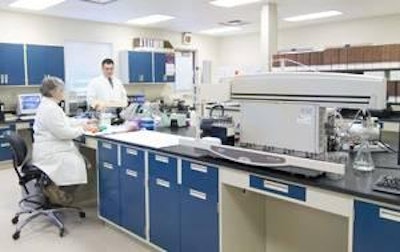
In the business of poultry breeding it is essential that the salmonella status be determined as quickly and as regularly as possible. Breeder companies operate within the guidelines of the National Poultry Improvement Plan (NPIP), which requires that all birds used to produce hatching eggs be free of Salmonella enteritiditis and S. typhimurium.
Historically, the detection and identification of Salmonella spp. has been achieved with conventional bacterial culture. Environmental samples from the environment of chicken houses, egg collection belts, hatchery waste and installations are collected using swabs. Samples are then placed into specialized selective media which promote the preferential growth of salmonella species in the presence of potential competing enteric bacteria. Samples of this media are then transferred to selective growth media in petri dishes or agar slopes that contain indicators that change color only in the presence of salmonella. Additional culture and testing is then required to determine which species of salmonella are present. These multiple culture steps require 7 to 10 days to determine if salmonella was present in the environmental swab and to subsequently identify the species.
Infected flocks should not be used as a source of breeding stock, as their chicks could be contaminated by the vertical route and serve to disseminate infection through hatcheries and rearing farms by the horizontal route. It is essential that the presence of the pathogen should be identified as rapidly as possible so that appropriate preventive action can be taken. It is also important to identify the specific salmonella that is present since there are over 2,000 different serotypes. Some of these occur naturally in the environment and are not harmful to either humans or chickens. Others such as S. enteritiditis and S. typhimurium can potentially cause illness in humans.
The polymerase chain reaction (PCR) procedure is now available for rapid detection of the DNA of salmonella. PCR tests are rapid and are also very sensitive and can even detect salmonella that does not grow well on artificial media in the laboratory. Salmonella can also be detected using an immunologic antibody detection method in association with conventional microbiologic culture.
The Hy-Line International laboratory uses the BAX PCR-based assay developed by DuPont. This assay allows detection of salmonella within 32 hours of sampling, thus providing rapid turnaround time necessary for a breeding company or a commercial application. Hy-Line was involved with the validation of this method, now approved by the NPIP for the poultry industry. While the BAX test detects the presence of salmonella, it does not identify the species. The Hy-Line laboratory performs an additional PCR test requiring 4 hours to differentiate between S. enteritiditis and S. typhimurium.
Swabs are taken routinely for salmonella analysis. Once every week in houses with pure line birds, flocks undergoing evaluation or reproduction for grandparents are sampled for salmonella. We test grandparent flocks every two weeks. Swabs consist of a sterile gauze pad which is moistened and transported in 10 ml of double strength skim milk (DSSM) to the laboratory. Swabs are obtained at various locations within a chicken house including egg belts, nests, floors, dust, fans and pits. Hatcheries are also subjected to routine monitoring for the possible presence of salmonella. Incubators, setters, hatchers, trays and equipment are sampled. In addition swabs are obtained from meconium, feed, mice and flies to be screened for Salmonella spp.
Currently, the majority of samples that are routinely monitored for salmonella are analyzed using either the Dupont Qualicon BAX DNA-based PCR salmonella protocol or the traditional culture method. If a sample is negative on the BAX PCR test, it is considered negative and testing is complete at that point. Random negative BAX PCR tests are plated on traditional media in order to verify that no positive samples are being overlooked.
A salmonella-positive sample on the BAX PCR test is confirmed using the traditional culture method. Many non-urgent routine samples are analyzed using the traditional culture method with delayed secondary enrichment if needed. All positive samples from either test method are serotyped to rule out Group D salmonella and isolates are referred to the National Veterinary Service laboratory for confirmation of identity.

















